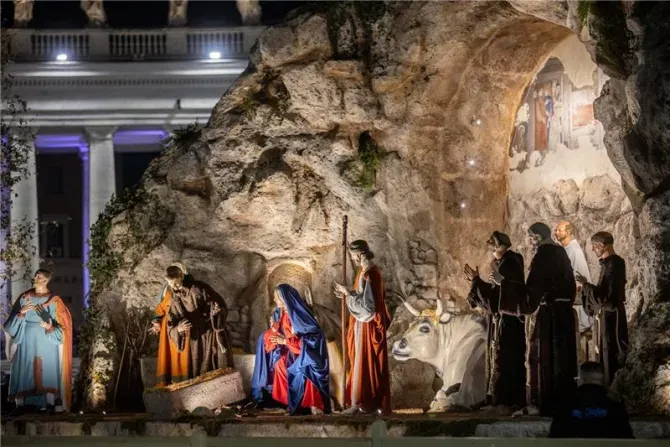
The Vatican unveiled its annual Nativity scene Friday evening, paying special tribute to the origins of the beloved tradition on its 800th anniversary.
The scene in St. Peter’s Square depicts not only Mary and Joseph standing beside the manger but also St. Francis of Assisi, who organized the first Nativity scene in a cave in the Italian village of Greccio on Christmas Eve in 1223.
Cardinal Fernando Vérgez Alzaga, the president of the Governorate of Vatican City State, presided over the Dec. 9 inauguration ceremony.
Over a thousand people gathered in the square for the event, which included moments of catechesis, an explanation of how the scene was put together, and the signing of seasonal hymns.
The Vatican’s Greccio-inspired Nativity scene does not include live animals and people as St. Francis’ original did, but it does feature life-sized terracotta figures, crafted by renowned Neapolitan sculptor Antonio Cantone.
At the center of the scene is the now-empty manger, where a figure of the newborn savior will be placed on Christmas Eve. On one side of manger, Mary kneels, flanked by Joseph, while on the other side, St. Francis of Assisi stands in a pose of wonder.
In addition to Mary, Joseph, St. Francis, and the traditional ox and donkey, the 13th-century mayor of Greccio who helped organize the first Nativity scene, Giovanni Velita, is featured in statue form, along with his wife, Alticama.
Three Franciscan friars, whom St. Francis had tasked with setting up the first Nativity scene as a place where local faithful could come and contemplate the poverty of the incarnate Lord, are also depicted.
The backdrop of the scene is a replica of the fresco that decorates the Chapel of the Nativity in Greccio, which is built into the grotto where St. Francis set up the first Nativity scene. On one half of the fresco, he kneels in adoration of the Christ child; on the other side, Mary feeds the newborn savior while Joseph, the ox, and the donkey look on.
Underneath the fresco, a Franciscan friar is depicted celebrating Mass in the grotto. The friar elevates the body of Christ directly behind the manger.
In another fitting tribute to the Nativity scene’s origins, this year’s Vatican display was provided by the Diocese of Rieti, which is where Greccio is located.
The Vatican’s Christmas tree was also lit at the Dec. 9 ceremony. The tree, an 80-foot-tall fir, had been donated by the Italian community of Macra, located in the northwest of Italy. The tree was adorned with edelweiss flowers that are native to the Alpine region. Upon lighting, it glowed with ever-changing patterns of green, blue, and red.
After the tree’s use in St. Peter’s Square, its wood will be used to make toys for children in need.
Earlier in the day, Pope Francis spoke
to delegations of the two communities that had donated the Nativity
scene and the Christmas tree. The pope said that meditating in front of
any Nativity scene should “awaken in us the nostalgia for silence and
prayer, in our often-so-hectic daily life.”
The pope also said that the Vatican Nativity scene’s connection to Greccio should in turn prompt people to think and pray for the inhabitants of the Holy Land amid the ongoing war between Israel and Hamas, especially children and their parents affected by the conflict.
“These are the ones who pay the real price of war,” Pope Francis said.
Both the Nativity scene and the tree will remain in St.
Peter’s Square until the feast of the Baptism of the Lord on Jan. 7,
2024.
